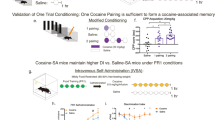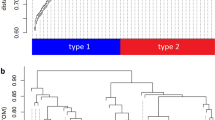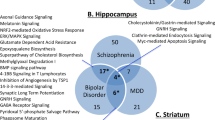ABSTRACT
CNS-focused cDNA microarrays were used to examine gene expression profiles in dorsolateral prefrontal cortex (dlPFC, Area 46) from seven individual sets of age- and post-mortem interval-matched male cocaine abusers and controls. The presence of cocaine and related metabolites was confirmed by gas chromatography-mass spectrometry. Sixty-five transcripts were differentially expressed, indicating alterations in energy metabolism, mitochondria and oligodendrocyte function, cytoskeleton and related signaling, and neuronal plasticity. There was evidence for two distinct states of transcriptional regulation, with increases in gene expression predominating in subjects testing positive for a metabolite indicative of recent ‘crack’ cocaine abuse and decreased expression profiles in the remaining cocaine subjects. This pattern was confirmed by quantitative polymerase chain reaction for select transcripts. These data suggest that cocaine abuse targets a distinct subset of genes in the dlPFC, resulting in either a state of acute activation in which increased gene expression predominates, or a relatively destimulated, refractory phase.
This is a preview of subscription content, access via your institution
Access options
Subscribe to this journal
Receive 6 print issues and online access
$259.00 per year
only $43.17 per issue
Buy this article
- Purchase on Springer Link
- Instant access to full article PDF
Prices may be subject to local taxes which are calculated during checkout





Similar content being viewed by others
Abbreviations
- PFC:
-
prefrontal cortex
- DlPFC:
-
dorsolateral prefrontal cortex
- CDNA:
-
complementary DNA
- DNA:
-
deoxyribonucleic acid
- RNA:
-
ribonucleic acid
- PCR:
-
polymerase chain reaction
- QPCR:
-
quantitative polymerase chain reaction
References
Vanderschuren LJMJ, Kalivas PW . Alterations in dopaminergic and glutamatergic transmission in the induction and expression of behavioral sensitization: a critical review of preclinical studies. Psychopharmacology (Berl) 2000; 151: 99–120.
Wolf ME . The role of excitatory amino acids in behavioral sensitization to psychomotor stimulants. Prog Neurobiol 1998; 54: 679–720.
Nestler EJ . Molecular basis of long-term plasticity underlying addiction. Nat Rev Neurosci 2001; 2: 119–128.
Robinson T, Gorny G, Mitton E, Kolb B . Cocaine self-administration alters the morphology of dendrites and dendritic spines in the nucleus accumbens and neocortex. Synapse 2001; 39: 257–266.
Striplin CD, Kalivas PW . Correlation between behavioral sensitization to cocaine and G protein ADP-ribosylation in the ventral tegmental area. Brain Res 1992; 579: 181–186.
Kalivas PW, Duffy P . Time course of extracellular dopamine and behavioral sensitization to Cocaine. II. Dopamine perikarya. J Neurosci 1993; 13: 276–284.
Hope BT, Nye HE, Kelz MB, Self DW, Iadarola MJ, Nakabeppu Y et al. Induction of a long-lasting AP-1 complex composed of altered Fos-like proteins in brain by chronic cocaine and other chronic treatments. Neuron 1994; 13: 1235–1244.
Steketee JD, Rowe LA, Chandler LJ . The effects of acute and repeated cocaine injections on protein kinase C activity and isoform levels in dopaminergic brain regions. Neuropharmacology 1998; 37: 339–347.
Ghasemzadeh MB, Nelson LC, Lu X-L, Kalivas PW . Neuroadaptations in ionotropic and metabotropic glutamate receptor mRNA produced by cocaine treatment. J Neurochem 1999; 72: 157–165.
Persico AM, Schindler CW, O'Hara BF, Brannock MT, Uhl GR . Brain transcription factor expression: effects of acute and chronic amphetamine and injection stress. Mol Brain Res 1993; 20: 91–100.
Koob GF, Sanna PP, Bloom FE . Neuroscience of addiction. Neuron 1998; 21: 467–476.
Stein EA, Fuller SA . Cocaine's time action profile on regional cerebral blood flow in the rat. Brain Res 1993; 626: 117–126.
Hammer Jr RP, Cooke ES . Gradual tolerance of metabolic activity is produced in mesolimbic regions by chronic cocaine treatment, while subsequent cocaine challenge activates extrapyramidal regions of rat brain. J Neurosci 1994; 14: 4289–4298.
Hadfield MG . Cocaine. Selective regional effects on central monoamines. Mol Neurobiol 1995; 11: 47–53.
Beyer CE, Steketee JD . Dopamine depletion in the medial prefrontal cortex induces sensitized-like behavioral and neurochemical responses to cocaine. Brain Res 1999; 833: 133–141.
Jentsch JD, Taylor JR . Impulsivity resulting from frontostriatal dysfunction in drug abuse: implications for the control of behavior by reward-related stimuli. Psychopharmacology (Berl) 1999; 146: 373–390.
Breiter HC, Gollub RL, Weisskoff RM, Kennedy DN, Makris N, Berke JD et al. Acute effects of cocaine on human brain activity and emotion. Neuron 1997; 19: 591–611.
Maas LC, Lukas SE, Kaufman MJ, Weiss RD, Daniels SL, Rogers VW et al. Functional magnetic resonance imaging of human brain activation during cue-induced cocaine craving. Am J Psychiatry 1998; 155: 124–126.
Childress AR, Mozley PD, McElgin W, Fitzgerald J, Reivich M, O'Brien CP . Limbic activation during cue-induced cocaine craving. Am J Psychiatry 1999; 156: 11–18.
Garavan H, Pankiewicz J, Bloom A, Cho J-K, Sperry L, Ross TJ et al. Cue-induced cocaine craving: neuroanatomical specificity for drug users and drug stimuli. Am J Psychiatry 2000; 157: 1789–1798.
Volkow ND, Fowler JS . Addiction, a disease of compulsion and drive: involvement of the orbitofrontal cortex. Cereb Cortex 2000; 10: 318–325.
Bonson KR, Grant SJ, Contoreggi CS, Links JM, Metcalfe J, Weyl HL et al. Neural systems and cue-induced cocaine craving. Neuropsychopharmacology 2002; 26: 376–386.
Grant S, London ED, Newlin DB, Villemagne VL, Liu X, Contoreggi C et al.. Activation of memory circuits during cue-elicited cocaine craving. Proc Natl Acad Sci USA 1996; 93: 12040–12045.
Grant S, Contoreggi C, London ED . Drug abusers show impaired performance in a laboratory test of decision making. Neuropsychologia 2000; 38: 1180–1187.
Bechara A, Dolan S, Denburg N, Hindes A, Anderson SW, Nathan PE . Decision-making deficits, linked to a dysfunctional ventromedial prefrontal cortex, revealed in alcohol and stimulant abusers. Neuropsychologia 2001; 39: 376–389.
Pierce RC, Reeder DC, Hicks J, Morgan ZR, Kalivas PW . Ibotenic acid lesions of the dorsal prefrontal cortex disrupt the expression of behavioral sensitization to cocaine. Neuroscience 1998; 82: 1103–1114.
Everitt BJ, Parkinson JA, Olmstead MC, Arroyo M, Robledo P, Robbins TW . Associative processes in addiction and reward. The role of amygdala-ventral striatal subsystems. Ann NY Acad Sci 1999; 877: 412–438.
McFarland K, Kalivas PW . The circuitry mediating cocaine-induced reinstatement of drug-seeking behavior. J Neurosci 2001; 21: 8655–8663.
Egan MF, Goldberg TE, Kolachana BS, Callicott JH, Massanti CM, Straub RE et al. Effect of COMT Val108/158Met genotype on frontal lobe function and risk for schizophrenia. Proc Natl Acad Sci USA 2001; 98: 6917–6922.
Hitri A, Casanova MF, Kleinman JE, Wyatt RJ . Fewer dopamine transporter receptors in the prefrontal cortex of cocaine users. Am J Psychiatry 1994; 151: 1074–1076.
Mash DC, Pablo J, Ouyang Q, Hearn WL, Izenwasser S . Dopamine transport function is elevated in cocaine users. J Neurochem 2002; 81: 292–300.
Chen L, Segal DM, Moraes CT, Mash DC . Dopamine transporter mRNA in autopsy studies of chronic cocaine users. Mol Brain Res 1999; 73: 181–185.
Little KY, McLaughlin DP, Zhang L, Livermore CS, Dalack GW, McFinton PR et al. Cocaine, ethanol, and genotype effects on human midbrain serotonin transporter binding sites and mRNA levels. Am J Psychiatry 1998; 155: 207–213.
Mayfield RD, Lewohl JM, Dodd PR, Herlihy A, Liu J, Harris RA . Patterns of gene expression are altered in the frontal and motor cortices of human alcoholics. J Neurochem 2002; 81: 802–813.
Stevens JR . Enough of pooled averages: been there, done that. Biol Psychiatry 1997; 41: 633–635.
Mirnics K, Middleton FA, Marquez A, Lewis DA, Levitt P . Molecular characterization of schizophrenia viewed by microarray analysis of gene expression in prefrontal cortex. Neuron 2000; 28: 53–67.
Middleton FA, Mirnics K, Pierri JN, Lewis DA, Levitt P . Gene expression profiling reveals alterations of specific metabolic pathways in schizophrenia. J Neurosci 2002; 22: 2718–2729.
Freeman WM, Brebner K, Lynch WJ, Robertson DJ, Roberts DCS, Vrana KE . Cocaine-responsive gene expression changes in rat hippocampus. Neuroscience 2000; 108: 371–380.
Freeman WM, Nader MA, Nader SH, Robertson DJ, Gioia L, Mitchell SM et al. Chronic cocaine-mediated changes in non-human primate nucleus accumbens gene expression. J Neurochem 2001; 77: 542–549.
Young MR, Nair R, Bucheimer N, Tulsian P, Brown N, Chapp C et al. Transactivation of Fra-1 and consequent activation of AP-1 occur extracellular signal-regulated kinase dependently. Mol Cell Biol 2002; 22: 587–598.
Valjent E, Corvol JC, Pages C, Besson MJ, Maldonado R, Caboche J . Involvement of the extrallular signal-regulated kinase cascade for cocaine-rewarding properties. J Neurosci 2000; 20: 8701–8709.
Beitner-Johnson D, Guitart X, Nestler EJ . Neurofilament proteins and the mesolimbic dopamine system: common regulation by chronic morphine and chronic cocaine in the rat ventral tegmental area. J Neurosci 1992; 12: 2165–2176.
Guitart X, Beitner-Johnson D, Marby DW, Kosten TA, Nestler EJ . Fischer and Lewis rat strains differ in basal levels of neurofilament proteins and their regulation by chronic morphine in the mesolimbic dopamine system. Synapse 1992; 12: 242–253.
Garcia-Sevilla JA, Ventayol P, Busquets X, La Harpe R, Walzer C, Guimon J . Marked decrease of immunolabelled 68 kDa neurofilament (NF-L) proteins in brains of opiate addicts. Neuroreport 1997; 8: 1561–1565.
Bunnemann B, Terron A, Zantedeschi V, Merlo Pich E, Chiamulera C . Chronic nicotine treatment decreases neurofilament immunoreactivity in the rat ventral tegmental area. Eur J Pharmacol 2000; 393: 249–253.
Ferrer-Alcon M, Garcia-Sevilla JA, Jaquet PE, La Harpe R, Riederer BM, Walzer C et al. Regulation of nonphosphorylated and phosphorylated forms of neurofilament proteins in the prefrontal cortex of human opioid addicts. J Neurosci Res 2000; 61: 338–349.
Ulloa L, Dombradi V, Diaz-Nido J, Szucs K, Gergely P, Friedrich P et al. Dephosphorylation of distinct sites on microtubule-associated protein MAP1B by protein phosphatases 1, 2A and 2B. FEBS Lett 1993; 330: 85–89.
Strack S, Westphal RS, Colbran RJ, Ebner FF, Wadzinski BE . Protein serine/threonine phosphatase 1 and 2A associate with and dephosphorylate neurofilaments. Brain Res Mol Brain Res 1997; 49: 15–28.
Robinson TE, Kolb B . Alterations in the morphology of dendrites and dendritic spines in the nucleus accumbens and prefrontal cortex following repeated treatment with amphetamine or cocaine. Eur J Neurosci 1999; 11: 1598–1604.
Nestler EJ, Terwilliger RZ, Walker JR, Sevarino KA, Duman RS . Chronic cocaine treatment decreases levels of the G protein subunits Gi alpha and Goα in discrete regions of rat brain. J Neurochem 1990; 55: 1079–1082.
Strittmatter SM, Valenzuela D, Sudo Y, Linder ME, Fishman MC . An intracellular guanine nucleotide release protein for G0. GAP-43 stimulates isolated alpha subunits by a novel mechanism. J Biol Chem 1991; 266: 22465–22471.
Wang X-B, Funada M, Imai Y, Revay RS, Ujike H, Vandenbergh DJ et al. rGβ1: a psychostimulant-regulated gene essential for establishing cocaine sensitization. J Neurosci 1997; 17: 5993–6000.
Strittmatter SM, Valenzuela D, Kennedy TE, Neer EJ, Fishman MC . G0 is a major growth cone protein subject to regulation by GAP-43. Nature 1990; 344: 836–841.
Jiang M, Gold MS, Boulay G, Spicher K, Peyton M, Brabet P et al. Multiple neurological abnormalities in mice deficient in the G protein Go. Proc Natl Acad Sci USA 1998; 95: 3269–3274.
Jiang M, Spicher K, Boulay G, Wang Y, Birnbaumer L . Most central nervous system D2 dopamine receptors are coupled to their effectors by G0 . Proc Natl Acad Sci USA 2001; 98: 3577–3582.
Saras J, Franzen P, Aspenstrom P, Hellman U, Gonez LJ, Heldin CH . A novel GTPase-activating protein for Rho interacts with a PDZ domain of the protein-tyrosine phosphatase PTPL1. J Biol Chem 1997; 272: 24333–24338.
Ikeda M, Dohi T, Tsujimoto A . Inhibition of gamma-aminobutyric acid release from synaptosomes by local anesthetics. Anesthesiology 1983; 58: 495–509.
Karler R, Calder LD, Thai DK, Bedingfield JB . The role of dopamine and GABA in the frontal cortex of mice in modulating a motor-stimulant effect of amphetamine and cocaine. Pharmacol Biochem Behav 1998; 60: 237–244.
Kofuji P, Davidson N, Lester HA . Evidence that neuronal G-protein-gated inwardly rectifying K+ channels are activated by G beta gamma subunits and function as heteromultimers. Proc Natl Acad Sci USA 1995; 92: 6542–6546.
Slesinger PA, Stoffel M, Jan YN, Jan LY . Defective gamma-aminobutyric acid type B receptor-activated inwardly rectifying K+ currents in cerebellar granule cells isolated from weaver and Girk2 null mutant mice. Proc Natl Acad Sci USA 1997; 94: 12210–12217.
Lewohl JM, Wang L, Miles MF, Zhang L, Dodd PR, Harris RA . Gene expression in human alcoholism: microarray analysis of frontal cortex. Alcohol Clin Exp Res 2000; 24: 1873–1882.
Kanoh H, Kai M, Wada I . Molecular characterization of the type 2 phosphatidic acid phosphatase. Chem Phys Lipids 1999; 98: 119–126.
Harrison PJ, Kleinman JE . Methodological issues. In: Harrison PJ, Roberts GW (eds). The Neuropathology of Schizophrenia. Oxford University Press: New York, 2000, pp 339–350.
Barton AJ, Pearson RC, Najlerahim A, Harrison PJ . Pre- and postmortem influences on brain RNA. J Neurochem 1993; 61: 1–11.
Romanczyk TB, Shannon Weickert C, Webster MJ, Herman MM, Akil M, Kleinman JE . Alterations in trkB mRNA in the human prefrontal cortex throughout the lifespan. Eur J Neurosci 2002; 15: 269–280.
Vawter MP, Barrett T, Cheadle C, Sokolov BP, Wood WH, Donovan DM et al. Application of cDNA microarrays to examine gene expression differences. Brain Res Bull 2001; 55: 641–650.
Barrett T, Cheadle C, Wood WB, Teichberg D, Donovan DM, Freed WJ et al. Assembly and use of a broadly applicable neural cDNA microarray. Restor Neurol Neurosci 2001; 18: 127–135.
Lee PD, Sladek R, Greenwood CMT, Hudson TJ . Control genes and variability: absence of ubiquitous reference transcripts in diverse mammalian expression systems. Genome Res 2001; 12: 292–297.
Goidin D, Mamessier A, Staquet M-J, Schmitt D, Berthier-Vergnes O . Ribosomal 18S RNA prevails over glyceraldehyde-3-phosphate dehydrogenase and β-actin genes as internal standard for quantitative comparison of mRNA levels in invasive and noninvasive human melanoma cell subpopulations. Anal Biochem 2001; 295: 17–21.
Vandenbergh DJ, Persico AM, Hawkins AL, Griffin CA, Li X, Jabs EW et al. Human dopamine transporter gene (DAT1) maps to chromosome 5p15.3 and displays a VNTR. Genomics 1992; 14: 1104–1106.
Livak KJ, Flood SJ, Marmaro J, Giusti W, Deetz K . Allelic discrimination using fluorogenic probes and 5′ nuclease assay. Genet Anal 1999; 14: 143–149.
Eisen MB, Spellman PT, Brown PO, Botstein D . Cluster analysis and display of genome-wide expression patterns. Proc Natl Acad Sci USA 1998; 95: 14863–14868.
Siegel S, Castellan Jr NJ . The Wilcoxon signed ranks test. Nonparametric Statistics or the Behavioral Sciences, 2nd edn. McGraw-Hill: New York 1998, pp 87–95.
Acknowledgements
The authors gratefully acknowledge the expert assistance of Diane Teichberg and Chris Cheadle (DNA Array Unit, NIA IRP), and by Aaron Russell (BIS, NIDA IRP).
Author information
Authors and Affiliations
Corresponding author
Additional information
DUALITY OF INTEREST
None declared.
Rights and permissions
About this article
Cite this article
Lehrmann, E., Oyler, J., Vawter, M. et al. Transcriptional profiling in the human prefrontal cortex: evidence for two activational states associated with cocaine abuse. Pharmacogenomics J 3, 27–40 (2003). https://doi.org/10.1038/sj.tpj.6500146
Received:
Accepted:
Published:
Issue Date:
DOI: https://doi.org/10.1038/sj.tpj.6500146
Keywords
This article is cited by
-
Gene Network Dysregulation in Dorsolateral Prefrontal Cortex Neurons of Humans with Cocaine Use Disorder
Scientific Reports (2017)
-
The Alterations in Mitochondrial DNA Copy Number and Nuclear-Encoded Mitochondrial Genes in Rat Brain Structures after Cocaine Self-Administration
Molecular Neurobiology (2017)
-
Methamphetamine addiction: involvement of CREB and neuroinflammatory signaling pathways
Psychopharmacology (2016)
-
Nuclear calcium signalling in the regulation of brain function
Nature Reviews Neuroscience (2013)
-
Target Identification for CNS Diseases by Transcriptional Profiling
Neuropsychopharmacology (2009)



